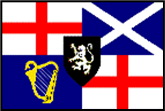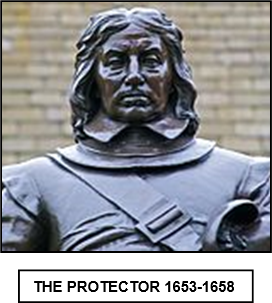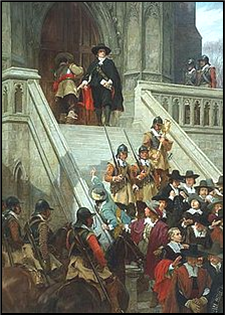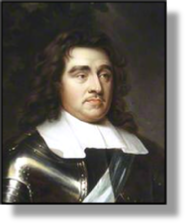


|
1649 |
Cromwell invades Ireland and ruthlessly puts down the Catholic rebellion, begun in 1644. He lays siege to Drogheda and Wexford and sacks both towns, killing most of their citizens.
In Russia, the system of serfdom, for long practised, is established officially by a law code introduced by Tsar Alexis. These harsh laws lead to a peasants' revolt later in his reign.
|
|
1650 |
The Scots, dissatisfied with Parliament, change sides and give their support to “Charles II”. Having returned to England, Cromwell invades Scotland and defeats the Scots at Dunbar. XXXXXXXXXXXXXXXXXXXXXXXXXXXXXXXXXXXXXXXXXXXXXXXXXXXXXXXXXXXXX
A loose alliance of tribes -
|
|
1651 |
Charles Stuart, having been "crowned" Charles II at Scone, leads a Scottish army into England, but is defeated by Oliver Cromwell at the decisive Battle of Worcester.
Thomas Hobbes, the English philosopher, writes his Leviathan, a work advocating absolute government as the only means of keeping man's nasty, brutish nature in check.
|
|
1652 |
Dutch pioneers, led by Commander Jan van Riebeeck, establish a trading post at Table Bay, Cape Town, to serve as a supply station for the Dutch East India Company.
A Dutch naval force
patrolling the Straits of Dover launches a surprise attack on
an English fleet commanded by Admiral Robert Blake. This
begins the first of three Anglo-
A coffee house is opened in London, the first of many. As we shall see (AN), these houses become important social, political and commercial meeting places in the life of the city.
|
|
1653 |
The Princely Fronde, a rebellion led by the Prince of Condé against royal supremacy, is crushed after 3 years of conflict. The absolute power of the crown is not seriously challenged again until 1789 (G3b).
|
|
1654 |
Otto von Guericke, having invented the first practical air pump, creates a vacuum and, by his "Magdeburg Hemispheres", publicly demonstrates the enormous force of air pressure.
The 16-
|
|
1655 |
The Dutch painter Jan Vermeer paints The Lacemaker, a work which typifies his interest in every day interior scenes, and illustrates his mastery of lighting, colour, tone and texture.
|
|
1656 |
Arithmeticxof Infinities is published by the English mathematician John Wallis. A founder member of the Royal Society, he makes important advances in algebra and geometry.
The French philosopher and scientist Blaise Pascal begins writing his Provincial Letters. His Thoughts appeared in 1670. He also makes advances in mathematics and physics.
A Venetian fleet soundly defeats the Ottoman Turks off the Dardanelles. By now, however, the city port of Venice, no longer on major world trade routes, begins to go into decline.
Havingxinvaded Poland, Charles X of Sweden defeats the Poles at the Battle of Warsaw. Faced with a powerful alliance, he then spends the next three years at war with Denmark.
AxComical History of the States and Empires of the Moon is published. An amusing satire by the French writer Cyrano de Bergerac, it is an early example of space fiction. |
|
1657 |
The first pendulum clock is produced by the Dutch scientist Christiaan Huygens. He also makes important advances in mathematics, astronomy and the theory of light.
The Moravian pastor Jan Comenius
(Komensky) compiles Didactica
Opera Omnia, a collection of his writings on
education, advocating new methods of teaching and full- |
|
1658 |
Oliver Cromwell dies. His son, Richard Cromwell, becomes the second Lord Protector of England but, lacking the firm leadership required, the Commonwealth begins to disintegrate.
The Mughal Emperor Shah Jahan, builder of the Taj Mahal, is deposed and imprisoned by his third son, Aurangzeb, the last of the famous Mughal leaders of northern India.
|
|
1659 |
Richard Cromwell resigns and flees abroad, leaving the country in total confusion. The Rump Parliament proves ineffective, and dissension breaks out among senior army officers.
The Treaty of the Pyrenees finally ends the war between France and Spain begun in 1535 during the Thirty Years' War. France now emerges as the major European power.
|
|
1660 |
General George Monck brings his army to London. The Long Parliament is recalled and invites Charles Stewart, eldest son of Charles I, to take the throne. After setting out his terms in the Declaration of Breda, the king, Charles II, enters London amid widespread rejoicing. |







 The
Puritan movement known as the Society of Friends, formed by
the English lay preacher George Fox
The
Puritan movement known as the Society of Friends, formed by
the English lay preacher George Fox The
Englishman
The
Englishman 



 xxxxx
xxxxx